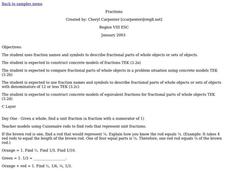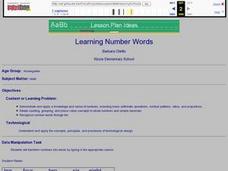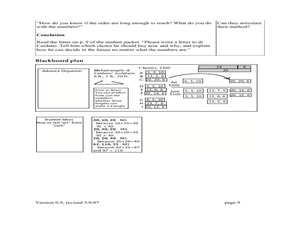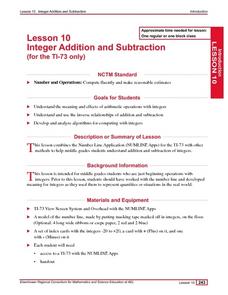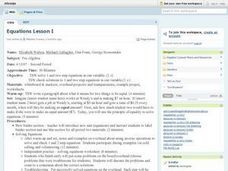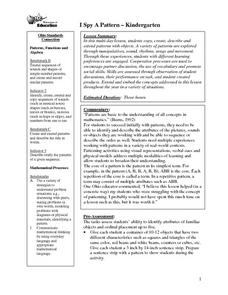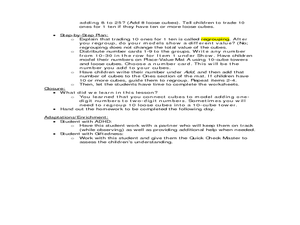Curated OER
Box Plots
Young statisticians are introduced to box plots and quartiles. They use an activity and discussion with supplemental exercises to help them explore how data can be graphically represented.
Curated OER
The Pythagorean Theorem
Students research Pythagoras and learn how to apply his theorem. They solve real life problems using the theorem and demonstrate knowledge of exponents, equations, and radicals. Students include diagrams in their research papers.
Curated OER
Fractions
Young mathematicians use fraction names and symbols to describe fractional parts of whole objects or sets of objects. They construct concrete models of fractions, and compare fractional parts of whole objects in a problem situation using...
Utah Education Network (UEN)
Linear Relationships: Tables, Equations, and Graphs
Pupils explore the concept of linear relationships. They discuss real-world examples of independent and dependent relationships. In addition, they use tables, graphs, and equations to represent linear relationships. They also use ordered...
Curated OER
Prime and Composite Number Mini Lab
Elementary schoolers determine the attributes of prime and composite numbers. Pupils, working in pairs, participate in an activity in which they use manipulatives to show the rectangles that can be made from square tiles. They practice...
Curated OER
Elementary Statistics in Life
Students examine newspapers for graphs. They collect and sort data that is of interest to them. They enter data into a database and make comparisons using the information.
Curated OER
Learning Number Words
Students practice saying their numbers and identifying the words. They use whole numbers and decimals to practice grouping numbers into different categories. They write the word of the number they are shown.
Curated OER
Direct, Inverse, And Joint Variation
Young scholars engage in a lesson that has them practice solving equations using multiplication and division. They practice solving problems using the properties needed and then students practice changing word problems into an equation.
Curated OER
Art or Junk? Discovering the Triangle Inequality
Middle schoolers study the triangle inequality. They will identify, compare, and analyze attributes of two and three-dimensional shapes. Then they develop vocabulary to describe the attributes. They also use manipulatives to analyze the...
Pennsylvania Department of Education
Shapes Around Us
Learners use manipulatives to study shapes. They sort shapes and use correct geometric terminology to describe them. Students find real-life examples of 2 and 3 dimensional shapes, and classify figures in their classroom according to...
Curated OER
So Many Cats!
First graders listen to the book, So Many Cats, and discuss the number of cats in the story. They demonstrate simple addition problems using cat counters and a work mat in the shape of a house.
Eisenhower Regioanl Consortium for Mathematics and Science Education
Lesson 10: Integer Addition and Subtraction (for the TI-73 only)
Using a number line on the floor made from masking tape and manipulatives, learners observe a demonstration of the addition and subtraction processes. After completing several worksheets, they solve three-term problems using calculators...
Curated OER
Equations Lesson 1
Middle schoolers engage in a study of equations and how they are solved using algebraic methods. This overrides the fact of guessing as done in earlier grades. They cover the concept of inverse operations as the main way to manipulate...
Fuel the Brain
Brain Boosters - Add Ten on a Number Line
Encourage learners to use pictures, numbers, or words to solve two-word problems in which they count by 10's using a number line. They tell the total number of items the child has in each problem by starting at a given number and adding...
Curated OER
Kinzi Deaf Alumni
Students use data of school alumni to create a database. The lesson uses technology and access to a computer lab is essential. The concepts of graphing statistics is also used to help teach across the curriculum.
Curated OER
The Tortoise And The Hare
Students use the children's story of The Tortoise And The Hare in order to investigate the graphing of equations. The story is converted to an algebraic word problem for them to solve. Students investigate the relationships of data and...
Curated OER
Word Power
Fifth graders identify a set of data from a real world problem. In this statistics lesson, 5th graders identify the range, mode, median and mean using some manipulatives. They write words randomizing the letters.
Curated OER
I Spy a Pattern-Kindergarten
Pupils copy, create, describe, and extend patterns with objects. They explore a variety of patterns through the use of manipulatives, sound, rhythms, songs and movement. Cooperative processes are used to encourage partner discussion.
Curated OER
Learn Fractions with Cuisenaire Rods
Students study fractions with the use of manipulatives. They use Cuisenaire Rods to visualize problems and solve them.
Curated OER
Justifying Answers
Students demonstrate how to solve word problems. In this problem solving lesson plan, students use strategies such as drawing pictures, using counters, and making a table to justify how they solved the word problem.
Curated OER
Place Value
Students use various manipulatives and play a game to practice place value and to help them visually see how many "ten" is.
Curated OER
Title Balancing With Tidy Numbers
Young scholars use math manipulatives (ice block sticks) to show the addition of two 2-digit numbers. They discuss short-cuts that might be used to make the problem easier. they apply the same principle for adding larger numbers, as well.
Curated OER
Factoring Trinomials
Students factor trinomials using algebra tiles and blocks. In this algebra lesson plan, students complete a trinomials station activity. They work backwords to find their answers and discuss their steps in a group.
Curated OER
Regrouping Ten Ones for One Ten
Students explore regrouping. In this hands-on math place value lesson, students construct models using connecting cubes and place value mats to solve simple addition problems that require regrouping.


